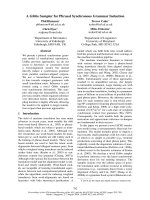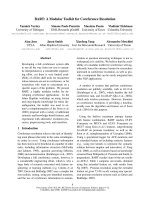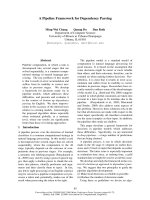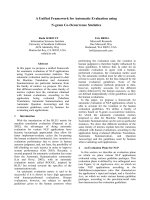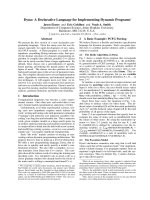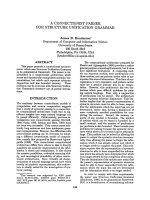Báo cáo khoa học: "A Bilingual Concordancer for Domain-Specific Computer Assisted Translation" potx
Bạn đang xem bản rút gọn của tài liệu. Xem và tải ngay bản đầy đủ của tài liệu tại đây (221.87 KB, 6 trang )
Proceedings of the 50th Annual Meeting of the Association for Computational Linguistics, pages 55–60,
Jeju, Republic of Korea, 8-14 July 2012.
c
2012 Association for Computational Linguistics
DOMCAT: A Bilingual Concordancer for Domain-Specific Computer
Assisted Translation
Ming-Hong Bai
1,2
Yu-Ming Hsieh
1,2
Keh-Jiann Chen
1
Jason S. Chang
2
1 Institute of Information Science, Academia Sinica, Taiwan
2 Department of Computer Science, National Tsing-Hua University, Taiwan
, ,
,
Abstract
In this paper, we propose a web-based
bilingual concordancer, DOMCAT
1
, for
domain-specific computer assisted
translation. Given a multi-word expression
as a query, the system involves retrieving
sentence pairs from a bilingual corpus,
identifying translation equivalents of the
query in the sentence pairs (translation
spotting) and ranking the retrieved sentence
pairs according to the relevance between
the query and the translation equivalents.
To provide high-precision translation
spotting for domain-specific translation
tasks, we exploited a normalized
correlation method to spot the translation
equivalents. To ranking the retrieved
sentence pairs, we propose a correlation
function modified from the Dice coefficient
for assessing the correlation between the
query and the translation equivalents. The
performances of the translation spotting
module and the ranking module are
evaluated in terms of precision-recall
measures and coverage rate respectively.
1 Introduction
A bilingual concordancer is a tool that can retrieve
aligned sentence pairs in a parallel corpus whose
source sentences contain the query and the
translation equivalents of the query are identified
in the target sentences. It helps not only on finding
translation equivalents of the query but also
presenting various contexts of occurrence. As a
result, it is extremely useful for bilingual
1
lexicographers, human translators and second
language learners (Bowker and Barlow 2004;
Bourdaillet et al., 2010; Gao 2011).
Identifying the translation equivalents,
translation spotting, is the most challenging part of
a bilingual concordancer. Recently, most of the
existing bilingual concordancers spot translation
equivalents in terms of word alignment-based
method. (Jian et al., 2004; Callison-Burch et al.,
2005; Bourdaillet et al., 2010). However, word
alignment-based translation spotting has some
drawbacks. First, aligning a rare (low frequency)
term may encounter the garbage collection effect
(Moore, 2004; Liang et al., 2006) that cause the
term to align to many unrelated words. Second, the
statistical word alignment model is not good at
many-to-many alignment due to the fact that
translation equivalents are not always correlated in
lexical level. Unfortunately, the above effects will
be intensified in a domain-specific concordancer
because the queries are usually domain-specific
terms, which are mostly multi-word low-frequency
terms and semantically non-compositional terms.
Wu et al. (2003) employed a statistical
association criterion to spot translation equivalents
in their bilingual concordancer. The association-
based criterion can avoid the above mentioned
effects. However, it has other drawbacks in
translation spotting task. First, it will encounter the
contextual effect that causes the system incorrectly
spot the translations of the strongly collocated
context. Second, the association-based translation
spotting tends to spot the common subsequence of
a set of similar translations instead of the full
translations. Figure 1 illustrates an example of
contextual effect, in which ‘Fan K'uan’ is
incorrectly spotted as part of the translation of the
query term ‘ 谿山行旅圖’ (Travelers Among
Mountains and Streams), which is the name of the
55
painting painted by ‘Fan K'uan/范寬’ since the
painter’s name is strongly collocated with the
name of the painting.
Sung , Travelers Among Mountains and Streams , Fan
K'uan
宋谿山行旅圖范寬
Figure 1. ‘Fan K'uan’ may be incorrectly spotted as
part of the translation of ‘谿山行旅圖’, if pure
association method is applied.
Figure 2 illustrates an example of common
subsequence effect, in which ‘清明上河圖’ (the
River During the Qingming Festival/ Up the River
During Qingming) has two similar translations as
quoted, but the Dice coefficient tends to spot the
common subsequences of the translations.
(Function words are ignored in our translation
spotting.)
Expo 2010 Shanghai-Treasures of Chinese Art Along
the River During the Qingming Festival
2010 上海世博會華夏百寶篇清院本清明上河圖
Oversized Hanging Scrolls and Handscrolls Up the
River During Qingming
巨幅名畫清沈源清明上河圖
Figure 2. The Dice coefficient tends to spot the common
subsequences ‘River During Qingming’.
Bai et al. (2009) proposed a normalized
frequency criterion to extract translation
equivalents form sentence aligned parallel corpus.
This criterion takes lexical-level contexture effect
into account, so it can effectively resolve the above
mentioned effect. But the goal of their method is to
find most common translations instead of spotting
translations, so the normalized frequency criterion
tends to ignore rare translations.
In this paper, we propose a bilingual
concordancer, DOMCAT, for computer assisted
domain-specific term translation. To remedy the
above mentioned effects, we extended the
normalized frequency of Bai et al. (2009) to a
normalized correlation criterion to spot translation
equivalents. The normalized correlation inherits
the characteristics of normalized frequency and is
adjusted for spotting rare translations. These
characteristics are especially important for a
domain-specific bilingual concordancer to spot
translation pairs of low-frequency and semantically
non-compositional terms.
The remainder of this paper is organized as
follows. Section 2 describes the DOMCAT system.
In Section 3, we describe the evaluation of the
DOMCAT system. Section 4 contains some
concluding remarks.
2 The DOMCAT System
Given a query, the DOMCAT bilingual
concordancer retrieves sentence pairs and spots
translation equivalents by the following steps:
1. Retrieve the sentence pairs whose source
sentences contain the query term.
2. Extract translation candidate words from the
retrieved sentence pairs by the normalized
correlation criterion.
3. Spot the candidate words for each target
sentence and rank the sentences by
normalized the Dice coefficient criterion.
In step 1, the query term can be a single word, a
phrase, a gapped sequence and even a regular
expression. The parallel corpus is indexed by the
suffix array to efficiently retrieve the sentences.
The step 2 and step 3 are more complicated and
will be described from Section 2.1 to Section 2.3.
2.1 Extract Translation Candidate Words
After the queried sentence pairs retrieved from the
parallel corpus, we can extract translation
candidate words from the sentence pairs. We
compute the local normalized correlation with
respect to the query term for each word e in each
target sentence. The local normalized correlation
is defined as follows:
f
q
f
q
feq
j
i
f
j
f
i
fep
fep
elnc
||)|(
||)|(
),,;(
(1)
where q denotes the query term, f denotes the
source sentence and e denotes the target sentence,
is a small smoothing factor. The probability p(e|f)
is the word translation probability derived from the
entire parallel corpus by IBM Model 1 (Brown et
al., 1993). The sense of local normalized
correlation of e can be interpreted as the
probability of word e being part of translation of
the query term q under the condition of sentence
pair (e, f).
56
Once the local normalized correlation is
computed for each word in retrieved sentences, we
compute the normalized correlation on the
retrieved sentences. The normalized correlation is
the average of all lnc values and defined as follows:
n
i
ii
elnc
n
enc
1
)()(
),,;(
1
);( feqq
(2)
where n is the number of retrieved sentence pairs.
After the nc values for the words of the retrieved
target sentences are computed, we can obtain a
translation candidate list by filtering out the words
with lower nc values.
To compare with the association-based method,
we also sorted the word list by the Dice coefficient
defined as follows:
)()(
),(2
),(
q
q
q
freqefreq
efreq
edice
(3)
where freq is frequency function which computes
frequencies from the parallel corpus.
Candidate words NC
mountain
0.676
stream
0.442
traveler
0.374
among
0.363
sung 0.095
k'uan 0.090
Figure 3(a). Candidate words sorted by nc values.
Candidate words Dice
traveler
0.385
reduced 0.176
stream
0.128
k'uan 0.121
fan 0.082
among
0.049
mountain
0.035
Figure 3(b). Candidate words sorted by Dice coefficient
values.
Figure 3(a) and (b) illustrate examples of
translation candidate words of the query term ‘谿
山行旅圖’ (Travelers Among Mountains and
Streams) sorted by the nc values, NC, and the Dice
coefficients respectively. The result shows that the
normalized correlation separated the related words
from unrelated words much better than the Dice
coefficient.
The rationale behind the normalized correlation
is that the nc value is the strength of word e
generated by the query compared to that of
generated by the whole sentence. As a result, the
normalized correlation can easily separate the
words generated by the query term from the words
generated by the context. On the contrary, the Dice
coefficient counts the frequency of a co-occurred
word without considering the fact that it could be
generated by the strongly collocated context.
2.2 Translation Spotting
Once we have a translation candidate list and
respective nc values, we can spot the translation
equivalents by the following spotting algorithm.
For each target sentence, first, spot the word with
highest nc value. Then extend the spotted sequence
to the neighbors of the word by checking their nc
values of neighbor words but skipping function
words. If the nc value is greater than a threshold θ,
add the word into spotted sequence. Repeat the
extending process until no word can be added to
the spotted sequence.
The following is the pseudo-code for the
algorithm:
S is the target sentence
H is the spotted word sequence
θis the threshold of translation candidate words
Initialize:
H←
e
max
←S[0]
Foreach e
i
in S:
If nc(e
i
) > nc(e
max
):
e
max
←e
i
If nc(e
max
)θ:
add
e
max
toH
Repeat until no word add to H
e
j
←leftneighborofH
Ifnc(e
j
)θ:
adde
j
toH
e
k
←rightneighborofH
If nc(e
k
)θ:
adde
k
toH
Figure 4: Pseudo-code of translation spotting process.
57
2.3 Ranking
The ranking mechanism of a bilingual
concordancer is used to provide the most related
translation of the query on the top of the outputs
for the user. So, an association metric is needed to
evaluate the relations between the query and the
spotted translations. The Dice coefficient is a
widely used measure for assessing the association
strength between a multi-word expression and its
translation candidates. (Kupiec, 1993; Smadja et
al., 1996; Kitamura and Matsumoto, 1996;
Yamamoto and Matsumoto, 2000; Melamed, 2001)
The following is the definition of the Dice
coefficient:
)()(
),(2
),(
qt
qt
qt
freqfreq
freq
dice
(4)
where q denotes a multi-word expression to be
translated, t denotes a translation candidate of q.
However, the Dice coefficient has the common
subsequence effect (as mentioned in Section 1) due
to the fact that the co-occurrence frequency of the
common subsequence is usually larger than that of
the full translation; hence, the Dice coefficient
tends to choose the common subsequence.
To remedy the common subsequence effect, we
introduce a normalized frequency for a spotted
sequence defined as follows:
n
i
ii
lnfnf
1
)()(
),,;(),( feqtqt (5)
where lnf is a function which compute normalized
frequency locally in each sentence. The following
is the definition of lnf:
tH
feqfeqt
e
elnclnf )),,;(1(),,;(
(6)
where H is the spotted sequence of the sentence
pair (e,f), H-t are the words in H but not in t. The
rationale behind lnf function is that: when counting
the local frequency of t in a sentence pair, if t is a
subsequence of H, then the count of t should be
reasonably reduced by considering the strength of
the correlation between the words in H-t and the
query.
Then, we modify the Dice coefficient by
replacing the co-occurrence frequency with
normalized frequency as follows:
)()(
),(2
),(
qt
qt
qt
freqfreq
nf
nf_dice
(7)
The new scoring function, nf_dice(t,q), is
exploited as our criterion for assessing the
association strength between the query and the
spotted sequences.
3 Experimental Results
3.1
Experimental Setting
We use the Chinese/English web pages of the
National Palace Museum
2
as our underlying
parallel corpus. It contains about 30,000 sentences
in each language. We exploited the Champollion
Toolkit (Ma et al., 2006) to align the sentence pairs.
The English sentences are tokenized and
lemmatized by using the NLTK (Bird and Loper,
2004) and the Chinese sentences are segmented by
the CKIP Chinese segmenter (Ma and Chen, 2003).
To evaluate the performance of the translation
spotting, we selected 12 domain-specific terms to
query the concordancer. Then, the returned spotted
translation equivalents are evaluated against a
manually annotated gold standard in terms of recall
and precision metrics. We also build two different
translation spotting modules by using the GIZA++
toolkit (Och and Ney, 2000) with the
intersection/union of the bidirectional word
alignment as baseline systems.
To evaluate the performance of the ranking
criterion, we compiled a reference translation set
for each query by collecting the manually
annotated translation spotting set and selecting 1 to
3 frequently used translations. Then, the outputs of
each query are ranked by the nf_dice function and
evaluated against the reference translation set. We
also compared the ranking performance with the
Dice coefficient.
3.2 Evaluation of Translation Spotting
We evaluate the translation spotting in terms of the
Recall and Precision metrics defined as follows:
2
58
||
||
1
)(
1
)()(
n
i
i
g
n
i
ii
g
H
HH
Recall
(8)
||
||
1
)(
1
)()(
n
i
i
n
i
ii
g
H
HH
Precision
(9)
where i denotes the index of the retrieved
sentence,
)(i
H
is the spotted sequences of the ith
sentence returned by the concordancer, and
)(i
g
H
is
the gold standard spotted sequences of the ith
sentence. Table 1 shows the evaluation of
translation spotting for normalized correlation, NC,
compared with the intersection and union of
GIZA++ word alignment. The F-score of the
normalized correlation is much higher than that of
the word alignment methods. It is noteworthy that
the normalized correlation increased the recall rate
without losing the precision rate. This may indicate
that the normalized correlation can effectively
conquer the drawbacks of the word alignment-
based translation spotting and the association-
based translation spotting mentioned in Section 1.
Recall Precision F-score
Intersection
0.4026 0.9498
0.5656
Union 0.7061 0.9217 0.7996
NC 0.8579 0.9318 0.8933
Table 1. Evaluation of the translation spotting
queried by 12 domain-specific terms.
We also evaluate the queried results of each
term individually (as shown in Table 2). As it
shows, the normalized correlation is quite stable
for translation spotting.
Query terms
GIZA Intersection GIZA Union NC
R P F R P F R P F
毛公鼎 (Maogong cauldron)
0.27 0.86 0.41 0.87 0.74 0.80 0.92 0.97
0.94
翠玉白菜(Jadeite cabbage)
0.48 1.00 0.65 1.00 0.88 0.94 0.98 0.98
0.98
谿山行旅圖(Travelers Among Mountains and Streams)
0.28 0.75 0.41 1.00 0.68 0.81 0.94 0.91
0.92
清明上河圖(Up the River During Qingming)
0.22 0.93 0.35 0.97 0.83 0.89 0.99 0.91
0.95
景德鎮(Ching-te-chen)
0.50 0.87 0.63 0.73 0.31 0.44 1.00 0.69
0.82
瓷器(porcelain)
0.53 0.99 0.69 0.93 0.64 0.76 0.78 0.96
0.86
霽青(cobalt blue glaze)
0.12 1.00 0.21 0.85 0.58 0.69 0.94 0.86
0.90
銘文(inscription)
0.20 0.89 0.32 0.71 0.34 0.46 0.88 0.95
0.91
三友百禽(Three Friends and a Hundred Birds)
0.58 0.99 0.73 1.00 0.97
0.99
1.00 0.72 0.84
狂草(wild cursive script)
0.42 1.00 0.59 0.63 0.80 0.71 0.84 1.00
0.91
蘭亭序(Preface to the Orchid Pavilion Gathering)
0.33 0.75 0.46 0.56 0.50 0.53 0.78 1.00
0.88
後赤壁賦(Latter Odes to the Red Cliff)
0.19 0.50 0.27 0.75 0.46 0.57 0.94 0.88
0.91
Table 2. Evaluation of the translation spotting for each term
3.3 Evaluation of Ranking
To evaluate the performance of a ranking function,
we ranked the retrieved sentences of the queries by
the function. Then, the top-n sentences of the
output are evaluated in terms of the coverage rate
defined as follows:
coverage
queries of #
top-nin on translatia findcan queries of #
(10)
The meaning of the coverage rate can be
interpreted as: how many percent of the query can
find an acceptable translation in the top-n results.
We use the reference translations, as described in
Section 3.1, as acceptable translation set for each
query of our experiment. Table 3 shows the
coverage rate of the nf_dice function compared
with the Dice coefficient. As it shows, in the
outputs ranked by the Dice coefficient, uses
usually have to look up more than 3 sentences to
find an acceptable translation; while in the outputs
ranked by the nf_dice function, users can find an
acceptable translation in top-2 sentences.
59
dice nf_dice
top-1 0.42 0.92
top-2 0.75 1.00
top-3 0.92 1.00
Table 3. Evaluation of the ranking criteria.
4 Conclusion and Future Works
In this paper, we proposed a bilingual
concordancer, DOMCAT, designed as a domain-
specific computer assisted translation tool. We
exploited a normalized correlation which
incorporate lexical level information into
association-based method that effectively avoid the
drawbacks of the word alignment-based translation
spotting as well as the association-based translation
spotting.
In the future, it would be interesting to extend
the parallel corpus to the internet to retrieve more
rich data for the computer assisted translation.
References
Bai, Ming-Hong, Jia-Ming You, Keh-Jiann Chen, Jason
S. Chang. 2009. Acquiring Translation Equivalences
of Multiword Expressions by Normalized Correlation
Frequencies. In Proceedings of EMNLP, pages 478-
486.
Bird, Steven and Edward Loper. 2004. NLTK: The
Natural Language Toolkit. In Proceedings of ACL,
pages 214-217.
Bourdaillet, Julien, Stéphane Huet, Philippe Langlais
and Guy Lapalme. 2010. TRANSSEARCH: from a
bilingual concordancer to a translation finder.
Machine Translation, 24(3-4): 241–271.
Bowker, Lynne, Michael Barlow. 2004. Bilingual
concordancers and translation memories: A
comparative evaluation. In Proceedings of the
Second International Workshop on Language
Resources for Translation Work, Research and
Training , pages. 52-61.
Brown, Peter F., Stephen A. Della Pietra, Vincent J.
Della Pietra, Robert L. Mercer. 1993. The
Mathematics of Statistical Machine Translation:
Parameter Estimation. Computational Linguistics,
19(2):263-311.
Callison-Burch, Chris, Colin Bannard and Josh
Schroeder. 2005. A Compact Data Structure for
Searchable Translation Memories. In Proceedings of
EAMT.
Gao, Zhao-Ming. 2011. Exploring the effects and use of
a Chinese–English parallel concordancer. Computer-
Assisted Language Learning 24.3 (July 2011): 255-
275.
Jian, Jia-Yan, Yu-Chia Chang and Jason S. Chang. 2004.
TANGO: Bilingual Collocational Concordancer. In
Proceedings of ACL, pages 166-169.
Kitamura, Mihoko and Yuji Matsumoto. 1996.
Automatic Extraction of Word Sequence
Correspondences in Parallel Corpora. In Proceedings
of WVLC-4 pages 79-87.
Kupiec, Julian. 1993. An Algorithm for Finding Noun
Phrase Correspondences in Bilingual Corpora. In
Proceedings of ACL, pages 17-22.
Liang, Percy, Ben Taskar, Dan Klein. 2006. Alignment
by Agreement. In Proceedings of HLT-NAACL 2006,
pages 104-111, New York, USA.
Ma, Wei-Yun and Keh-Jiann Chen. 2003. Introduction
to CKIP Chinese word segmentation system for the
first international Chinese word segmentation
bakeoff. In Proceedings of the second SIGHAN
workshop on Chinese language processing, pages
168-171.
Ma, Xiaoyi. 2006. Champollion: A Robust Parallel Text
Sentence Aligner. In Proceedings of the Fifth
International Conference on Language Resources
and Evaluation.
Melamed, Ilya Dan. 2001. Empirical Methods for
Exploiting parallel Texts. MIT press.
Moore, Robert C. 2004. Improving IBM Word-
Alignment Model 1. In Proceedings of ACL, pages
519-526, Barcelona, Spain.
Och, Franz J., Hermann Ney., 2000, Improved
Statistical Alignment Models, In Proceedings of ACL,
pages 440-447. Hong Kong.
Smadja, Frank, Kathleen R. McKeown, and Vasileios
Hatzivassiloglou. 1996. Translating Collocations for
Bilingual Lexicons: A Statistical Approach.
Computational Linguistics, 22(1):1-38.
Wu, Jian-Cheng, Kevin C. Yeh, Thomas C. Chuang,
Wen-Chi Shei, Jason S. Chang. 2003. TotalRecall: A
Bilingual Concordance for Computer Assisted
Translation and Language Learning. In Proceedings
of ACL, pages 201-204.
Yamamoto, Kaoru, Yuji Matsumoto. 2000. Acquisition
of Phrase-level Bilingual Correspondence using
Dependency Structure. In Proceedings of COLING,
pages 933-939.
60


